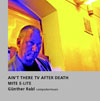|
Homage to a power generator
a commission of the IEM, Graz
In Siebenwirthen there is no electric power connection.
If in some cases electronic devices are to be used, one has to put an old McCulloch Mite E-Lite generator into operation. The motor also has to be started up to pump water out of the well into a higher lying reservoir (one notices that the reservoir is full when the spill water ripples over the roof).
Sure, there would be newer, environmentally-friendly, muffled models of generators.
However, the sound of Mite-E-Lite is more beautiful. It has character. It tells a story.
The recording of such a process (the starting-up, the kicking-in, the first backfiring and, lastly, the autonomous stalling of the engine) builds the basis of the whole composition. The sound itself and its rhythmic and harmonic structures find utilization within the piece. The first spectral analyses showed an enormous abundance of partial tones above the bottom frequency of the two-stroke rhythm. Amazingly, the seventeenth and thirty-first partial tones are particularly dominant. It was therefore self-evident to approach the matter with prime number harmonics.
Viewed rhythmically, the process consists of a plethora of short explosions, each one different from the other, although they altogether form the typical “mechanical” rhythm of a motor, which proves to be extremely lively.
Excommunication – The original sound of the motor starting up is heard in the center.
Gradually it is broken down into its spectral components on the basis of the first 11 prime numbers (2-31). They become independent and wander outwards until they ultimately form an organ-like dome of sound.
Blue Note Seventeen – Three of these spectral components (3,7,5) dissolve into a trio in which, corresponding to the characteristics of prime number harmonics, a number of ‘blue notes’ are secured around the 17th partial tone. The rhythms are an interpretation of a phase of the motor in which it runs in a cycle; the melodies are derived from the differences of the single strokes. A stylistic mimicry reminiscent of Dixieland is created.
Unfortunately Viennese – Three other spectral components (11, 13, 2) form anew into a trio, whose rhythm, however, is now constructed out of the odd pulses. The whole piece takes on a stumbling and weepy style known from some Viennese folk songs.
Panopticum – Spectral distortions transform all the components into droves of bell-like sounds that are ringing something in. But no one knows exactly what this something is.
Swan Song – All prime numbers newly form into a slowly developing sequence of two chords that sound as if they could have never been any different.
Fade Away – They flow once again into the original sound of the motor, which finally dissolves completely and ebbs away.
G.R.
translated by Brian Dorsey
|
 |
|
Hommage an einen Stromgenerator
Auftragskomposition des IEM, Graz
In Siebenwirthen gibt es keinen Stromanschluss.
Wenn man fallweise dennoch elektrische Geräte in Betrieb nehmen will, muss man einen alten Generator der Type McCulloch Mite E-Lite in Betrieb nehmen. Auch um Wasser aus dem Brunnen in ein höher gelegenes Reservoir zu pumpen, muss man den Motor anwerfen. (Dass das Reservoir voll ist, merkt man daran, dass Wasser aus dem Ueberlauf über das Dach plätschert).
Sicher, es gäbe neuere, umweltfreundliche, schallgedämpfte Modelle von Generatoren.
Der Klang von Mite E-Lite aber ist schöner, er hat Charakter, er erzählt eine Geschichte.
Die Aufnahme eines solchen Prozesses (das Starten, das Anlaufen, die ersten Fehlzündungen und schliesslich das eigenständige Absterben des Motors) bildet die Grundlage der ganzen Komposition. Sowohl der Klang selbst, als auch seine rhythmischen und harmonischen Strukturen finden darin Verwendung.
Die ersten spektralen Analysen zeigten eine enorme Fülle an Teiltönen über der Grundfrequenz des Zweitakt-Rhythmus. Erstaunlicherweise sind insbesondere der siebzehnte und der einundreissigste Teilton stark dominant. Es war daher naheliegend, mit Primzahlharmonik an die Sache heranzugehen.
Rhythmisch betrachtet besteht der Prozess aus einer Fülle kurzer Explosionen, von denen keine der anderen gleicht, obwohl sie zusammengenommen den typisch maschinellen Rhythmus eines Motors bilden, der sich somit als höchst lebendig erweist.
Exkommunikation – Im Zentrum startet der Motor im Originalklang. Nach und nach wird er aufgelöst in seine spektralen Komponenten auf der Basis der ersten 11 Primzahlen (2-31). Sie verselbständigen sich und wandern nach aussen, bis sie schliesslich zusammen einen orgelartigen Klangdom bilden.
Blue Note Seventeen – Drei dieser spektralen Komponenten (3,7,5) formieren sich zum Trio, in dem gemäss den Eigenheiten der Primzahlharmonik, rund um den 17. Teilton, jede Menge 'blue notes‘ gesichert sind. Die Rhythmen sind eine Interpretation einer Phase des Motors, in der er rund läuft; die Melodien sind abgeleitet von den Unterschieden der einzelnen Takte. Es entsteht eine stilistische Mimikry, die an Dixieland erinnert.
Leider Wiener – Drei andere spektrale Komponenten (11,13,2) formieren neuerlich ein Trio, dessen Rhytmus aber jetzt aus den ‘schlechten‘ Taktteilen konstruiert ist. Das Ganze bekommt einen stolpernden und larmoyanten Duktus, wie man ihn von manchen Wienerliedern her kennt.
Panoptikum – Spektrale Verzerrungen transformieren alle Komponenten zu Scharen von glockenartigen Klängen, die irgendetwas einläuten. Man weiss aber nicht genau, was.
Abgesang – Sämtliche Primzahlkomponenten formieren sich neu zu einer langsam sich entwickelnden Folge von zwei Akkorden, die so klingen, als könnte es nie anders gewesen sein.
Ausklang – Sie münden wiederum in den Originalklang des Motors, der schliesslich gänzlich aufgelöst wird und verebbt. |
 |
